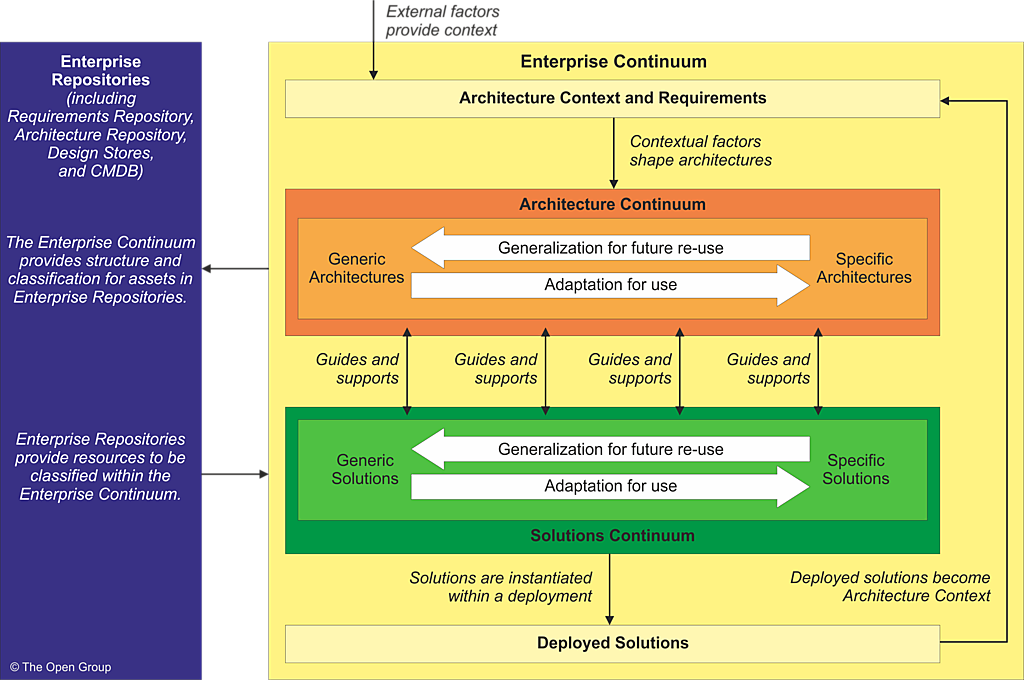Understanding the Constituents of the Enterprise Continuum in TOGAF
The Enterprise Continuum is a fundamental concept in the TOGAF (The Open Group Architecture Framework) that provides a structured approach for classifying and organizing architecture and solution assets within an organization. It serves as a framework for understanding the relationships between various architectural components and ensuring that they align with the overall enterprise strategy.
Overview of the Enterprise Continuum
The Enterprise Continuum is partitioned into three distinct continua:
- The Enterprise Continuum
- The Architecture Continuum
- The Solutions Continuum
These continua collectively help enterprises manage and leverage their architectural assets effectively.

1. The Enterprise Continuum
The Enterprise Continuum is the outermost continuum that classifies assets related to the overall context of the Enterprise Architecture. It includes various contextual assets that influence architectures but are not directly applied during the Architecture Development Method (ADM). These assets may include:
- Policies and Standards: Guidelines that govern architectural decisions and practices.
- Strategic Initiatives: Business goals and programs that drive architectural development.
- Organizational Structures: The hierarchical arrangement of roles and responsibilities within the enterprise.
- Enterprise-Level Capabilities: The core competencies and functions of the organization.
Additionally, the Enterprise Continuum can categorize solutions, distinguishing between contextual assets and specific implementations. It also encompasses two specializations: the Architecture Continuum and the Solutions Continuum.
2. The Architecture Continuum
The Architecture Continuum provides a consistent framework for defining and understanding the generic rules, representations, and relationships within an architecture. Key features include:
- Traceability and Derivation Relationships: This aspect shows how an Organization-Specific Architecture is derived from industry or generic standards.
- Architecture Building Blocks (ABBs): These are reusable architecture assets that evolve from abstract concepts to fully defined Organization-Specific Architecture components.
The Architecture Continuum helps identify relationships among foundational frameworks (like TOGAF), common system architectures (such as the Integrated Information Infrastructure Reference Model – III-RM), industry architectures, and overall Enterprise Architectures. By structuring these components, the Architecture Continuum aids in discovering commonalities and eliminating redundancy, ensuring that the architecture is efficient and aligned with strategic goals.
3. The Solutions Continuum
The Solutions Continuum complements the Architecture Continuum by providing a framework for describing and understanding the implementation of assets defined within the architecture. Key aspects include:
- Solution Building Blocks (SBBs): Reusable components available in the organizational environment that represent specific solutions.
- Implementation Agreements: The results of collaborations between customers and business partners that embody the rules and relationships established in the architecture.
The Solutions Continuum addresses the commonalities and differences among various products, systems, and services, ensuring that the implemented solutions are consistent with the overarching architectural framework.
Significance of the Enterprise Continuum
The Enterprise Continuum serves multiple critical functions:
- Classification of Assets: It classifies architecture assets applicable across the entire scope of Enterprise Architecture, helping organizations manage their architectural resources effectively.
- Communication and Understanding: By providing a clear structure, the Enterprise Continuum facilitates communication among stakeholders, ensuring that everyone understands the context and relevance of various architectural components.
- Building Blocks: The assets within the Enterprise Continuum can be viewed as building blocks that define and constrain the Enterprise Architecture. These can include business goals, strategic initiatives, capabilities, policies, and principles, all working together to shape the organization’s architecture.
Here’s a summary of the main points about the constituents of the Enterprise Continuum in tabular format:
| Constituent | Description | Key Features |
|---|---|---|
| Enterprise Continuum | The outermost continuum classifying assets related to the overall context of Enterprise Architecture. | – Classifies contextual assets (policies, standards, strategic initiatives, etc.)
– Influences architectures but not directly used in ADM |
| Architecture Continuum | Provides a framework for defining and understanding rules, representations, and relationships within an architecture. | – Defines traceability and derivation relationships
– Structures Architecture Building Blocks (ABBs) for reuse and evolution |
| Solutions Continuum | Describes and understands the implementation of assets defined in the Architecture Continuum. | – Defines reusable Solution Building Blocks (SBBs)
– Addresses agreements between customers and partners for solution implementation |
| Significance of the Enterprise Continuum | – Classifies architecture assets across the enterprise<br>- Facilitates communication and understanding among stakeholders<br>- Defines building blocks (goals, initiatives, policies) shaping Enterprise Architecture. | – Ensures alignment with business goals
– Enhances collaborative understanding – Aids in effective resource management |
This table summarizes the key constituents of the Enterprise Continuum, their descriptions, and their key features for easy reference.
Conclusion
The Enterprise Continuum is a powerful tool for organizations seeking to manage their architecture and solution assets effectively. By structuring these assets into the Enterprise Continuum, Architecture Continuum, and Solutions Continuum, organizations can ensure alignment with business goals, facilitate effective communication, and leverage reusable components. Understanding and utilizing the Enterprise Continuum is essential for architects and stakeholders aiming to build a coherent and strategic Enterprise Architecture that drives business success.

